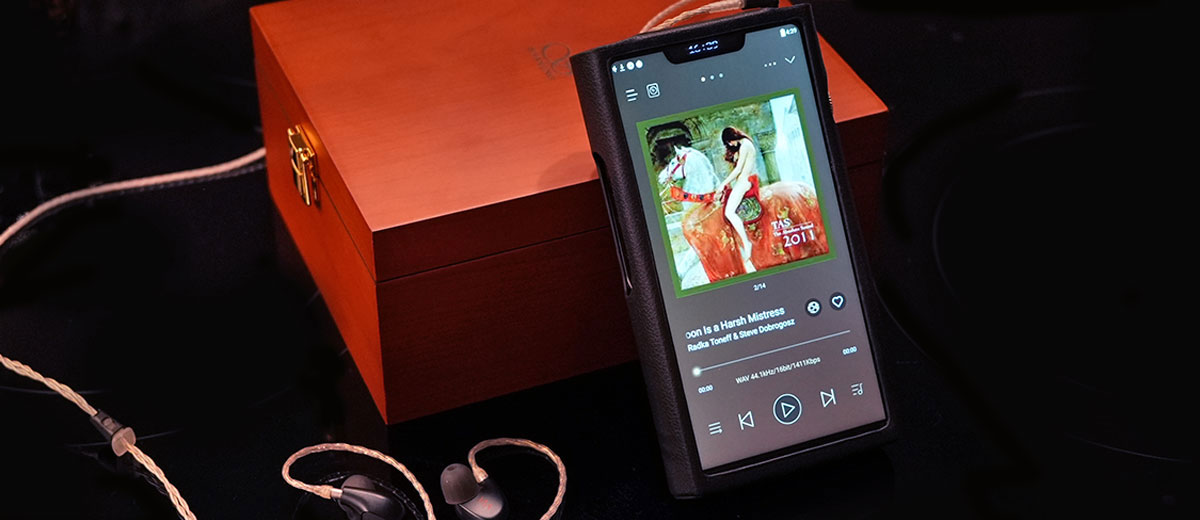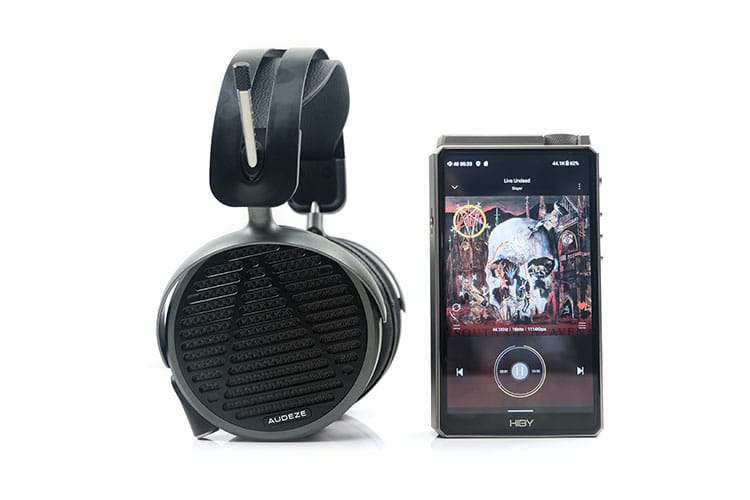Select Comparisons
Shanling M9
$2799
Technical
The Shanling M9 adapts dual AK4499EQ chipsets and due to its scarcity, it is limited to 500 pcs worldwide. Other features include Android 10, a similar OP+BUF architecture using ADA4896-2, LPF OPA1662, ADA4610-2, and BUF634a. The M9 is capable of delivering up to 920mW of output power.
Design
The M9 has a unique design that elevates the screen yet it is made not as portable when compared to the newer M9 Plus which can be fully protected by the leather case.
I still feel like the M9 is a showpiece for home use as you can’t avoid scratching it with the stock case, and it is bigger than the M9 Plus that I would consider putting it in my day-pack.
The M9 Plus has the design and utility polished and has taken away the swappable jacks which is a fun but probably not necessary feature, and the result is welcoming.
Performance
The price for the M9 Plus is only a tad bit higher than the M9 but the performance leap is night and day just like how the M9 sounds more defined than the M8.
If you have written our coverage on the M9 then you may remember our remarks saying that the M9 is not the most powerful DAP out there for headphones.
From the specs, we didn’t see Shanling improving much on raw power delivery but when putting it to actual tests, the bass does sound fuller and meatier on the M9 Plus, with the dynamics enhanced as well. This is likely because of the enhanced current output with the new amping stage designs as well as the result of 4 DAC chips.
With sensitive IEMs, you can feel the background being darker on the M9 Plus and the dynamics improved, with the treble zone rendered more extended, detailed, and relaxed. The width higher impedance IEMs the bass is more defined with airier bites and dynamics with stronger vocal separation power.
Ultimately the M9 Plus is more versatile and considering the better portability too it is a clear win in every aspect.
HiBy RS8
$3299
Technical
The HiBy RS8 is HiBy’s TOTL digital audio player riding on the newer Android 12 OS with fancier system features. The same Snapdragon 665 controller is used as well as 8GB of RAM and 256GB of storage.
Unlike its siblings the RS8 moves to R-2R technology instead of delta-sigma decoding, supporting 1Bit PCM decoding through its Darwin II architecture that can be seen on the RS2 player I reviewed earlier. The RS8 features Class A amplification and can output as much as 780mW to its balanced output.
There are also a lot of digital filtering functions on the RS8 which could make the output more flexible and enjoyable.
Design
With a full Titanium chassis, the RS8 is shaped to be very masculine and bold, also more premium, and rigid in terms of materials. That is quite different from M9 Plus’s design which is much more streamlined.
While the RS8 has a more unique design, the M9 Plus’s longer, 6-inch 2K resolution SHARP panel looks fancier than RS8’s 1920*1080 screen.
The HiBy RS8 weighs in at 584g, possibly due to its huge 12000mAh battery, while the M9 Plus is just 379g, which is 35% lighter making it much less hefty for everyday carry.
Performance
In terms of raw power delivery, under Turbo power mode on the RS8 and Extra Turbo mode on the M9 Plus, which are their respective “headphone modes”, both units sound equally energetic and powerful in the bass when paired with the HD650.
However, the M9 Plus is lusher sounding in the mid-lows and has a more agile bass response. The RS8 sounds cleaner and smoother compared to the M9 Plus with a swifter mids presentation. It outlines the vocal clearly with more presence in the harmonics, and cymbals and woodwinds sound more aggressive and textured.
I consider both devices quite neutral with the RS8 leaning slightly more to the treble and the M9 Plus to the bass. The M9 Plus sounds more organic and rounded, which makes it more immersive plus relaxing, and it is more enjoyable for jazzes, bass guitars, and strings.
In most pairings, the RS8 tends to have a more exciting treble response, but it may lack some of the control and richness, particularly at higher volume levels. Its sound signature is cooler and more V-shaped, making it well-suited for fast, percussion-heavy music, synthesized instruments, and cleaner vocals.
Personally, I find that the RS8’s sound signature, derived from its R-2R architecture, gives it a special quality when it comes to harmonics.
The technology being used is very different and so are the resulting sound signatures. While the RS8 enriches the harmonics and reverberations beautifully when listening to violins and New Age.
The M9 Plus’s dense and impactful low end and its vocal authority with strong dynamics and control are impressive.
FiiO M17
$1799
Technical
The M9 Plus comes slightly closer to M17’s 1.5W output power @32ohm load this time compared to M9. However, on paper, it is still quite far from the M17’s 3W output power when using an AC adaptor.
The M17 features Snapdragon 660 SoC, Dual ES9038PRO DAC, and a custom THX AAA 788+ amplifier. Its output impedance is measured at <2Ω, THD+N at <0.0007%, with SNR >121dB.
The M9 Plus features a stronger MCU, newer DACs, lower output impedance measured below 1Ω, and 126dB SNR which is quite a bit higher, allowing better efficiency with sensitive pairings.
The M17 is equipped with 4GB RAM and 64GB ROM, while the M9 Plus has fast 8GB RAM and 256GB ROM on board which is reflected in system speed when multi-tasking.
The M9 Plus is also able to do full unfolding for MQA while the M17 is only capable of 8X unfolding. When it comes to decoding, the M17 is able to decode up to DSD256 and PCM384, while the M9 Plus can handle DSD1024 and PCM 1536kHz.
Design
The design and build of the M17 and M9 Plus DAPs are significantly different, with the M17 being near twice the weight and featuring a more masculine appearance compared to the M9 Plus’s streamlined design.
These differences reflect the two companies’ distinct approaches, with the M17 focusing on packing in bulkier components for high output, while the M9 Plus prioritizes practicality and power in a more compact size.
Both approaches have their merits, but in technical terms, the M9 Plus is more portable, while the M17 should be considered semi-portable only due to its heavier weight.
Performance
Back when we covered the M9 we have done a comparison to the M17, which is still FiiO’s flagship player at this moment. There is another fact that doesn’t change as well, the FiiO M17 is the more powerful player here and can output up to 3W into 32Ω when plugging into DC power.
The M17 is definitely more capable of driving headphones that need the swing, such as the HD600, but the tradeoff is that when it is to handle smaller loads, it sounds more compressed, especially from upper mids onwards.
Compared to the M9, the M9 Plus has come quite a bit closer to M17’s performance being able to kick in stronger dynamics and fullness in the lows, but probably due to the fact that the HD600 uses SE output, the stronger output power on M17 is still giving it a good advantage to sound expansive and responsive.
With the Venus Planar headphone that terminated in 4.4mm, the M9 Plus is doing a great job of delivering punchy and full-bodied bass. The stronger current output from the quad DACs working in parallel should be the reason behind turning to higher volume there is still plenty of resolution and a distinctive vocal image.
Switching to the M17 with mid gain, it sounds cleaner and firmer, leaning more to the treble end with sharper transients while the bass attacks with more agility.
I enjoy M9 Plus’s tonality more as the mids and bass are more organic and full-bodied, and the treble less pushy. The M17 is obviously more powerful though the M9 Plus is offering a stronger sense of stableness and control in its output which makes it a better match in this case.
Our Verdict
The Shanling M9 Plus is a beast of a DAP which delivers similar if not better technical performance to some of the competition costing significantly more, all within an impressively portable package.
Strictly speaking, I would still like to see Android 12 or more premium housing materials, but considering the rather conservative charging price for the M9 Plus it would still make it on top of the recommendation list.
While there has been skepticism around splitting decoding chipsets for higher performance, the Shanling M9 Plus utilizes a convincing design with the AK4499EX and proprietary I/V amplification that strikes an excellent balance between portability, output power, tonality, and musicality.
Both balanced and Single-ended IEMs users have been catered for and this is a huge plus for those who have a larger collection of gears.
Shanling M9 Plus Technical Specifications
- Size: 147mm x 82mm x 22mm
- Weight: 379g
- Display: 6-inch 1080×2160
- System: Open Android 10
- CPU: Qualcomm Snapdragon 665
- Memory: 8G RAM & 256G ROM & Micro SD card slot
- DAC System: 2x AKM AK4191 & 4x AKM AK4499EX
- USB Input: XMOS XU316
- Bluetooth version: 5.0
- Bluetooth Transmitter: LDAC / LHDC 5.0 / aptX HD / aptX / SBC
- Bluetooth Receiver: LDAC / SBC
- WiFi: 2.4G/5G, SyncLink / DLNA / AirPlay / OTA upgrade
- Battery life: 18 h SE /11 h BAL
- Battery capacity: 8350 mAh, supports QC3.0 fast charging
Single-ended Output
- Output Power: 4.08V @ 32Ω (520mW)
- Frequency Response: 20Hz – 40kHz (0.2dB)
- THD+N: 0.0008%
- Separation: 75dB@32Ω
- Dynamic range: 123dB
- Signal-to-noise ratio: 123dB
- Noise floor: >115dB (<1.7uV) (low gain)
- Output impedance: less than 1Ω
Balanced Output
- Output Power: 6.0V @ 32Ω (1125mW)
- Frequency Response: 20Hz – 40kHz (-0.2dB)
- THD+N: 0.0007%
- Separation: 115dB@32Ω
- Dynamic range: 126dB
- Signal-to-noise ratio: 126dB
- Noise floor: >113dB(<2.3uV) (low gain)
- Output impedance: less than 1Ω






